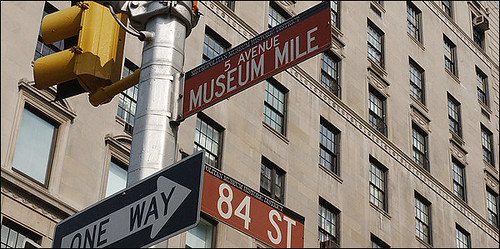Changing times for US arts museums
 Museum Mile street sign, New York City. Photo Credit: Helayne Seidman For The Washington Post.
Museum Mile street sign, New York City. Photo Credit: Helayne Seidman For The Washington Post.The Economist reports in "Onwards and upwards" that more than 33% of the directors of major arts museums are at retirement age, and opines that there are three major issues facing museums that the next generation of directors should address.
From the article:
The impending influx of new blood at the top offers museums an opportunity to rethink the job and question many of the assumptions that underlie traditional museum operations: the emphasis on splendid buildings, the primacy of curatorial authority and the balance between rich donors, for whom museums are often personal vanity projects, and the public, who see museums as shared common goods. ...------
Refashioning museums to appeal to future generations means devising a new vision. Up-and-coming directors face three major challenges: engaging more imaginatively with audiences, addressing America’s changing demographics and negotiating the ever more delicate balance between rich donors and the public.
Audience engagement has to do with a museum’s relevance and its impact on its community. The simplest measure is attendance figures. Engaging younger audiences is key, though; the National Endowment for the Arts reports that in the decade to 2012 the only age group that saw a marked growth in attendance was those aged 75 and older. his must change. ...
If museums are to make any headway in engaging with audiences they must also work on broadening their appeal. Last month the AAM annual conference was told that the three Ws of traditional museums are white, Western and “womanless”. ...
The biggest challenge facing new directors, though, will be keeping true to the idea of what a museum should be: a plaything for rich collectors whose philanthropy comes with an increasing number of conditions, or a precious centre of public education. In her speech Ms Cole reminded AAM delegates that baby-boomers still control 70% of the nation’s disposable income, and that wealth is being concentrated in fewer and fewer hands. Navigating successfully between these competing visions will separate the best art-museum director from the rest.
I do think that a kind of community history-art museum hybrid has a better chance at dealing with some of these issues. There was a lot of hand wringing on the part of the next generation of museum professionals about art and protest in the face of Black Lives Matters protests, starting in Ferguson, Missouri.
I had made a similar point in "Local history museums and critical analysis opportunities for communities."
But there is a tension in museums, as art was probably the first sector ever truly "globalized," between the collection and presentation of art by the great artists and civilizations vs. the presentation and collection of historical and contemporary work by local and regional artists. This can make it difficult for locally-based museums (as opposed to "national" museums like the big ones in New York City) to accomplish what The Economist suggests they must focus on.
The Museum of the City of New York addresses the concerns expressed by The Economist, although they could probably do a better job on diversity elements (although the city also has the Museum of El Barrio and one of the nation's premier collections of African-American materials at the Schomburg Center for Research in Black Culture of the New York Public Library system.
MCNY presents historical and artistic works in the context of the city's history and contemporary issues. Recent exhibits featured Mac Conner, an illustrator for magazines and ads during the heyday of illustrations (versus photography) and contemporary digital composite photographs by Jeff Chien-Hsing Liao's New York.
An earlier exhibition on "the decorative arts" presented the development of Colonial Revival as a style of architecture and interior design as well as an element of building national identity. Plus that great exhibit on "local" protest in New York City mentioned in the above-cited blog entry.
I seem to recall that the Montreal Fine Arts Museum successfully works the balance between presentation of globally- and regionally-relevant art.
In line with the challenge posted by The Economist, the Brooklyn Museum of Arts has appointed a new director ("Brooklyn Museum Picks Anne Pasternak as New Director," New York Times), who has been president and artistic director of Creative Time, NYC's leading force for public art and for visual and performing arts presented in the public realm.
In addition to the thousands of works commissioned and presented, Creative Time sponsors an annual conference, the Creative Time Summit, addressing key issues in public art. While most of the events have been held in NYC, last year's was in Stockholm and this year it's being held in association with the Venice Biennale, in August.
Labels: arts-culture, city museums, museums, public history, urban history



1 Comments:
Much thanks to you for giving such significant data, and a debt of gratitude is for sharing this Business Promotion system.
Post a Comment
<< Home